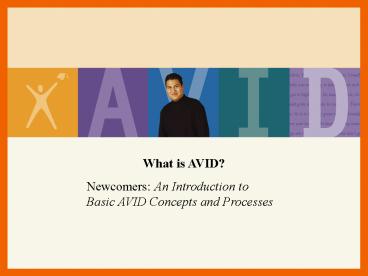What is AVID? - PowerPoint PPT Presentation
1 / 31
Title:
What is AVID?
Description:
Title: PowerPoint Presentation Author: Jerry Guzm n-Vergara Last modified by: Tonya D Leal Created Date: 6/16/2006 6:24:42 PM Document presentation format – PowerPoint PPT presentation
Number of Views:228
Avg rating:3.0/5.0
Title: What is AVID?
1
What is AVID? Newcomers An Introduction to
Basic AVID Concepts and Processes
2
AVID Program Advancement Via
Individual Determination L. avidus eager for
knowledge
3
We help our students find their voices by
believing in them, helping them become
academically competent, by encouraging them, and
by treating them not as members of a group, but
as individuals with unique skills, talents, and
passions. Once our students find their voices,
theres nothing they cant achieve.
Mary Catherine Swanson
4
The Mission of AVID
AVIDs mission is to close the achievement gap by
preparing all students for college readiness and
success in a global society.
5
The AVID Student Profile
- Students with Academic Potential
- Average to High Test Scores
- 2.0-3.5 GPA
- College Potential with Support
- Desire and Determination
- Meets one or More of the following Criteria
- First to Attend College
- Historically Underserved in 4-year Colleges
- Low Income
- Special Circumstances
6
A Sample Week in AVID Elective
Daily or Block Schedule
AVID Curriculum includes Writing
Curriculum College and Careers
Strategies for Success
AVID Tutorials Include Collaborative
Study Groups Writing Groups
Socratic Seminars
7
O
8
O
Writing Curriculum Writing
to Learn Writing Process
Focus Lessons Timed Writing
9
O
Cornell Notes
10
O
Cornell Note Taking System The STAR System
Set up your paper Take the notes
Apply your thinking to the
notes Reflect and Revise
your notes
11
O
An example of how notes are set up
Topic Heading
Questions Class Notes Subtitles Use
Bullets Headings Use Abbreviations (w/ _at_ etc.)
Summary 3 to 4 sentence summary across buttom
12
O
Summary Summary is added at the end of
all note pages on the subject
(not at the end of each page).
Summary is added AFTER questions
are finished.
13
O
14
O
Inquiry Method Engage in skillful
questioning Higher Level Thinking
Respectful dialogue
15
O
SOCRATIC SEMINARS a form
of structured discourse about ideas
and moral dilemmas.
Contribute to the development of vocabulary,
listening skills, interpretive and
comparative reading, textual
analysis, synthesis and evaluation.
Develops student centered dialogue which is at
the heart of rigor. Fosters
understanding of complex ideas and information.
16
O
17
O
Collaboration Students ask,
explore and answer questions
Students are listeners, thinkers, speakers,
and writers Students discover ideas and
remember because they are actively
involved Teacher becomes a coach, guiding
students in their learning
18
O
TUTORIALS Purpose Create
deeper understanding of concepts covered in core
content classes. Develop skills necessary to
become self-directed learners. It's not just
homework help! Process To
push each other's thinking. AVID tutorials
utilize an inquiry process. Tutors do not give
answers they facilitate the group's discovery
with critical questions. Students reflect on
their learning.
19
O
Organization AVID Binder Agenda Cornel
l Notes Tutorial Request Forms Portfolios
20
O
21
O
Reading to Learn Connect to prior
knowledge Understand Text Structure
Use text-processing strategies
(during and after reading)
22
O
Reciprocal Teaching Reciprocal teaching is an
instructional approach characterized by an
interactive dialogue between the teacher and
students in response to segments of a reading
selection The dialogue is based on four
processes Questioning Summarizing Clarifying
Predicting
23
O
Distinguishing Between Reading and Instructional
Strategies
Reading Strategies are deliberate, cognitive acts
learners use to bring meaning to a text.
Instructional strategies are the teaching
techniques teachers model and use to help
students become more independent readers and
learners.
24
AVID Program Essentials
- 1. AVID Student Selection
- 2. Voluntary Participation
- 3. AVID elective class offered during
- the school day
- 4. Rigorous course and study
- 5. Writing and Reading Curriculum
- 6. Inquiry to promote critical reading
25
AVID Program Essentials (Continued)
7. Collaboration 8. Trained tutors 9. Data
Collection and Analysis 10. District and School
Commitment 11. Active and Interdisciplinary Site
Team
26
Rigorous curriculum is a greater factor in
determining college graduation rates than class
standing, standardized test scores, or grade
point average. From Answers in the Tool Box
Academic Intensity, Attendance Patterns, and
Bachelor's Degree Attainment (1999) by Clifford
Adelman, Senior Research Analyst, U.S. Dept. of
Ed.
27
What is academic rigor?
Rigor is the goal of helping students develop the
capacity to understand content that is complex,
ambiguous, provocative, and personally or
emotionally challenging. Taking rigorous courses
opens doors ! Source Teaching What Matters
Most Standards and Strategies for Raising
Student Achievement by Strong, Silver and Perini,
ASCD, 2001.
28
Meeting the Challenge
To help all students do rigorous work and meet or
exceed high standards in each content area we
must help students Develop as readers and
writers. Develop deep content knowledge. Know
content specific strategies for reading,
writing, thinking and talking. Develop habits,
skills, and behaviors to use knowledge and
skills.
29
Meeting the Challenge (Continued)
30
Why AVID Works
- Places AVID students in rigorous curriculum and
gives them the support to achieve - Provides the explicit hidden curriculum of
schools - Provides a team of students for positive peer
identification - Redefines teachers role as that of student
advocate
31
from 2006 Summer Institute Tonya Leal, Blackstock
Jr. High School 8.19.12































